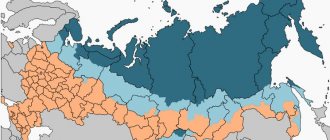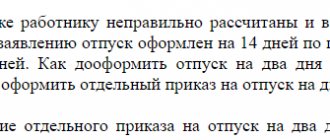Sick leave for a full month should not be less than the minimum wage
From April 1, 2021, a procedure for calculating benefits was established, according to which employers must pay temporary disability benefits so that, when calculated for a full month, it is not lower than the minimum wage (Article 1 of Federal Law No. 104-FZ dated April 1, 2020). Initially, it was planned that these rules would be in force until the end of 2021, but as a result they were made permanent (Parts 6.1, 6.2 of Article 14 of the Federal Law of December 29, 2006 No. 255-FZ, as amended by the Federal Law of December 29, 2020 No. 478 -FZ).
In areas where the regional coefficient is applied, the minimum wage is taken taking into account the regional coefficient. The employment rate is also taken into account - if an employee works part-time, the benefit is determined in proportion to its duration.
In fact, “bringing up” to the minimum wage was enshrined in legislation before. Average earnings are calculated for the two previous years. If during this period the salary was less than the minimum wage × 24, then the average daily earnings are calculated as the minimum wage × 24 / 730. But this did not always guarantee that the benefit amount for a full month would be more than the minimum wage. And that's why:
1. The benefit is not always calculated in the amount of 100% of average earnings (see Art. Federal Law No. 255-FZ of December 29, 2006). In particular, the benefit could be less than it is now under the new law for those who:
- less than eight years of experience (Clause 1, Article 7);
- the sick leave was after dismissal (clause 2 of article 7);
- sick leave to care for a sick child for more than 10 days (clause 3 of article 7).
2. Minimum wage × 24 / 730 = minimum wage / (730 / 24) = minimum wage / 30.417. Therefore, even with 100% payment for sick leave, the amount of the benefit would be less than under the new version of the law in months with less than 31 days (February, April, June, September, November).
The new calculation rules guarantee that the amount of benefits in terms of a full month will not be less than the minimum wage. First of all, this is good for workers with a salary close to the minimum wage and insurance coverage of less than 8 years.
Changes for part-time employees
For employees who work part-time, legislative innovations are also applicable. To compare actual and minimum earnings, you also need to take into account the regional coefficient .
However, the average earnings of such employees must be determined in proportion to the length of their working hours. For example, if an employee works part-time, we add a coefficient of 0.5. The formula for this calculation is as follows:
24 months * minimum wage * regional coefficient * employment coefficient / 730 days
The actual average daily earnings must be compared with the minimum wage calculated taking into account the Republic of Kazakhstan
The new rule applies to workers whose earnings over the previous two years turned out to be more than 24 minimum wages, but less than 24 minimum wages, taking into account the regional coefficient. Now, when comparing the average employee’s earnings with the minimum wage, you need to take into account the regional coefficient established in regions and localities (federal law dated 06/08/2020 No. 175-FZ).
According to the old FSS rules, it was possible to apply the regional coefficient only in the case when the average earnings calculated from the minimum wage turned out to be higher than the actual one. That is, the benefit was compared with the minimum average daily earnings and the regional coefficient was not applied if the actual earnings were more than the minimum. Because of this, it often happened that an employee with a lower income received sick leave in a larger amount over two years than a colleague with a higher income. Before the entry into force of 175-FZ, the average earnings calculated based on the income of the insured person were simply compared with the minimum wage × 24 / 730, and only if it turned out to be less, and the calculation was based on the minimum wage, the regional coefficient was applied to the final amount of the benefit (the FSS did not adhere to this position depending on judicial practice). In cases where the employee’s income for two years was more than 24 × the minimum wage, but less than 24 × the minimum wage × RK, this led to an underestimation of the amount of the benefit.
You can read more about this change in the article “Calculating sick leave in a new way: minimum wage, taking into account regional coefficients.” Be sure to check out the comments for even more explanations and examples from experts.
What is the regional coefficient
In the context of labor relations, the regional coefficient is understood as a financial indicator by which the salary (all its components - salary, bonuses, incentive payments) of a person working in regions (municipalities) is multiplied, in which:
1. As a rule, difficult climatic or environmental conditions are observed living conditions of citizens and work activities. For example, in the Far North and areas that are equivalent to it. Hence the unofficial name of the indicator - “northern coefficient”.
2. The corresponding regional coefficients are established by law.
Examples of regulations that set coefficients for certain regions (municipalities):
- Decree of the Government of the Russian Federation dated May 29, 1993 No. 512;
- Resolution of the State Committee for Labor of the USSR, the Secretariat of the All-Union Central Council of Trade Unions dated August 17, 1971 No. 325/24;
- Order of the Government of the Russian Federation dated January 29, 1992 No. 176-r.
A significant part of the regulations establishing coefficients were adopted in the USSR. In the absence of newer sources of law, they are recognized as fully valid.
A complete list of regional coefficients is available in ConsultantPlus. To view the Handbook, get a trial access to the legal system. It's free.
The regional coefficient is calculated on the salary regardless of the person’s work experience in general and in the region where the coefficient applies, in particular. This is the difference between the financial indicator under consideration and another similar in purpose - the percentage markup (often called the “northern markup”).
You can learn more about the use of regional coefficients and “northern bonuses” in the article “What benefits are available to employees of the Far North?”
Changing the minimum wage and limits for calculating sick leave
From 2021, the minimum wage will increase to 12,792 rubles, and the limits for calculating benefits will also change. We have compared the figures for 2021, 2021 and 2021 in the table. Please note that the comparison does not take into account regional coefficients and region.
| Index | 2019 | 2020 | 2021 |
| Minimum wage, rubles | 11 280 | 12 130 | 12 792 |
| Limit base for calculating benefits, rubles | 865 000 | 912 000 | 966 000 |
| Maximum daily benefit amount for: | |||
| 8 years of experience, rubles | 2 150,68 | 2 301,37 | 2 434,25 |
| experience from 5 to 8 years, rubles | 1 720,54 | 1 841,1 | 1 947,4 |
| up to 5 years of experience, rubles | 1 290,41 | 1 380,82 | 1 460,55 |
| Maximum daily benefit amount for: | |||
| months of 31 days, rubles | 363,87 | 391,29 | 412,65 |
| months of 30 days, rubles | 376 | 404,33 | 426,4 |
| in February, rubles | 402,86 | 418,28 | 456,86 |
What factors are used to determine the size of the coefficient for subjects?
The value of the correction factor used to equalize the income of the population is determined depending on the characteristics of the region. Factors taken into account include:
- transport provision of the territory;
- quantity, quality and availability of infrastructure;
- ecological situation;
- climatic conditions;
- geographical location of the region, etc.
According to information from Art. 316 of the Labor Code, the value of the indicator is determined and recorded by government bodies of the country. For some regions, data from legislation and regulations issued in the former USSR is used.
How to calculate sick leave in 2021
According to the new rules, it is necessary to calculate the minimum average daily earnings taking into account the regional coefficient and the employment coefficient. To do this, use the formula:
Minimum wage × RK × KZ × 24 / 730, where:
- Minimum wage - the minimum wage is taken as of the start date of sick leave, so if it started in December 2021, use the minimum wage of 12,130 rubles, if it started already in 2021 - 12,792 rubles;
- RK - regional coefficient;
- KZ - employment rate at the date of onset of disability;
- 24 is the number of months in two years;
- 730 is the number of calendar days in two years.
Then the calculated actual average daily earnings are compared with the minimum. For further calculation, the largest value of the two is selected. Now we need to calculate the amount of benefits that the employee should receive during the period of incapacity for work in accordance with the calculated average daily earnings. To do this, use the formula:
AVERAGE × PERCENTAGE × DAYS, where:
- AVERAGE - the amount of average daily earnings;
- PERCENTAGE - amount (percentage) of benefit payment;
- DAYS - the number of benefit days in a calendar month with this percentage of payment.
Then the amount received must be compared with the minimum benefit amount, calculated on the basis of the minimum wage, taking into account the regional coefficient and the employment coefficient. To do this, use the formula:
Minimum wage × RK × KZ × DAYS / KKD, where:
- Minimum wage is the minimum wage on the first day of the calendar month that is paid. So, if sick leave began in December and continued in January, then for December the amount will be 12,130 rubles, and for January 12,792 rubles;
- RK - regional coefficient;
- KZ - employment rate at the date of onset of disability;
- DAYS - benefit days falling on this calendar month;
- KKD - the number of calendar days in the month in which the period of incapacity is located.
Further, when calculating the benefit, the larger amount is used. If the minimum benefit amount is greater than the benefit calculated according to the average, then the employee will have to pay the minimum benefit amount.
Find out which regional coefficient applies in your area
Calculation example
The employee was sick from January 11 to January 21, 2021. His insurance experience is 3 years. The regional coefficient is 1.15. Over the previous two years, earnings amounted to 310,000 rubles.
We count:
| Calculation procedure | What would it be like in 2021 if there were no changes from June 19, 2020 | According to the new rules in 2021 |
| We calculate the average daily earnings (in fact) | 310,000 / 730 = 424.66 rubles | |
| We calculate the minimum average daily earnings | 12,792 rubles × 24 months / 730 days = 420.56 | 12,792 rubles × 1.15 (RK) × 24 months / 730 days = 483.64 |
| We compare, take the largest value | 420,56 < 424,66 | 483,64 > 424,66 |
| We calculate the amount of benefits based on average earnings | 424.66 rubles × 11 days × 60% (length of experience) = 2,802.76 rubles | 483.64 rubles × 11 days × 60% (length of experience) = 3,192.02 rubles |
| We calculate the minimum benefit value for 11 days of January | — | 12 792 × 1,15 × 11 / 31 = 5 219,96 |
| Compare the amount of benefits based on average earnings with the minimum benefit | — | 3 192,02 < 5 219,96 |
| Amount to be paid | 2 802,76 | 5 219,96 |
| Benefit for the employee | 2 417,86 | |
Employees whose earnings are significantly higher than the minimum wage or whose work experience is more than 8 years will not notice any changes in the calculation.
Calculate the amount of benefits under the new rules in a free calculator
In what cases is the regional coefficient for sick leave calculated?
As we already know, the regional coefficient is an indicator by which the salary of an employee working in a region for which the corresponding coefficient is determined by law is multiplied. When calculating sick leave, such multiplication is generally not carried out: this is due to the fact that disability benefits are calculated based on actual earnings (which have already been calculated and paid taking into account the established coefficients).
You can learn more about the features of calculating sick leave based on average earnings in the article “Average daily earnings for calculating sick leave.”
However, the regional coefficient when calculating sick leave can still be applied if:
1. The employee has an insurance period that does not exceed 6 months.
2. The employee’s average monthly earnings for the 2 years preceding the year in which the sick leave is issued is less than the minimum wage.
3. The employee did not work under the Labor Code of the Russian Federation for 2 years preceding the year in which the sick leave was issued (and, accordingly, did not have a salary).
4. The employee violated the treatment regimen.
5. The employee’s incapacity for work was due to intoxication.
Let us consider in more detail the procedure for calculating sick leave in these cases in practice.





